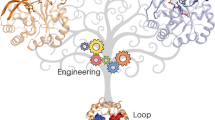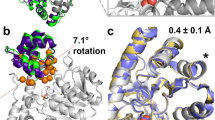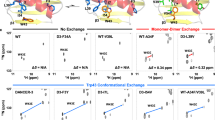Abstract
The current canon attributes the binding specificity of protein-recognition motifs to distinctive chemical moieties in their constituent amino acid sequences. However, we show for a WW domain that the sequence crucial for specificity is an intrinsically flexible loop that partially rigidifies upon ligand docking. A single-residue deletion in this loop simultaneously reduces loop flexibility and ligand binding affinity. These results suggest that sequences of recognition motifs may reflect natural selection of not only chemical properties but also dynamic modes that augment specificity.
This is a preview of subscription content, access via your institution
Access options
Subscribe to this journal
Receive 12 print issues and online access
$189.00 per year
only $15.75 per issue
Buy this article
- Purchase on Springer Link
- Instant access to full article PDF
Prices may be subject to local taxes which are calculated during checkout









Similar content being viewed by others
References
Sudol, M. & Hunter, T. New wrinkles for an old domain. Cell 103, 1001–1004 (2000).
Verdecia, M.A., Bowman, M.E., Lu, K.P., Hunter, T. & Noel, J.P. Structural basis for phosphoserine-proline recognition by group IV WW domains. Nat. Struct. Biol. 7, 639–643 (2000).
Zarrinpar, A., Bhattacharyya, R.P. & Lim, W.A. The structure and function of proline recognition domains. Sci. STKE 2003, RE8 (2003).
Wintjens, R. et al. 1H NMR study on the binding of PIN1 Trp-Trp domain with phosphothreonine peptides. J. Biol. Chem. 276, 25150–25156 (2001).
Jäger, M. et al. Structure-function-folding relationship in a WW domain. Proc. Natl. Acad. Sci. USA 103, 10648–10653 (2006).
Kowalski, J.A., Liu, K. & Kelly, J.W. NMR solution structure of the isolated Apo PIN1 WW domain: comparison to the x-ray crystal structures of PIN1. Biopolymers 63, 111–121 (2002).
Jacobs, D.M. et al. Peptide binding induces large scale changes in inter-domain mobility in human PIN1. J. Biol. Chem. 278, 26174–26182 (2003).
Bayer, E. et al. Structural analysis of the mitotic regulator hPIN1 in solution: insights into domain architecture and substrate binding. J. Biol. Chem. 278, 26183–26193 (2003).
Peng, J.W. & Wagner, G. Frequency spectrum of NH bonds in eglin c from spectral density mapping at multiple fields. Biochemistry 34, 16733–16752 (1995).
Ishima, R. & Nagayama, K. Protein backbone dynamics revealed by quasi spectral density function analysis of amide N-15 nuclei. Biochemistry 34, 3162–3171 (1995).
Farrow, N.A., Zhang, O., Szabo, A., Torchia, D.A. & Kay, L.E. Spectral density function mapping using 15N relaxation data exclusively. J. Biomol. NMR 6, 153–162 (1995).
Brutscher, B., Bruschweiler, R. & Ernst, R.R. Backbone dynamics and structural characterization of the partially folded A state of ubiquitin by 1H, 13C, and 15N nuclear magnetic resonance spectroscopy. Biochemistry 36, 13043–13053 (1997).
Massi, F., Johnson, E., Wang, C., Rance, M. & Palmer, A.G., III . NMR R1 rho rotating-frame relaxation with weak radio frequency fields. J. Am. Chem. Soc. 126, 2247–2256 (2004).
Luz, Z. & Meiboom, S. Nuclear magnetic resonance study of the protolysis of trimethylammonium ion in aqueous solution – order of the reaction with respect to solvent. J. Chem. Phys. 39, 366–370 (1963).
Trott, O. & Palmer, A.G., III . R1rho relaxation outside of the fast-exchange limit. J. Magn. Reson. 154, 157–160 (2002).
Carver, J.P. & Richards, R.E. A general two-site solution for the chemical exchange produced dependence of T2 upon the Carr-Purcell pulse separation. J. Magn. Reson. 6, 89–105 (1972).
Millet, O., Loria, J.P., Kroenke, C.D., Pons, M. & Palmer, A.G., III . The static magnetic field dependence of chemical exchange linebroadening defines the NMR chemical shift time scale. J. Am. Chem. Soc. 122, 2867–2877 (2000).
Lipari, G. & Szabo, A. Model-free approach to the interpretation of nuclear magnetic resonance relaxation in macromolecules. 1. Theory and range of validity. J. Am. Chem. Soc. 104, 4546–4559 (1982).
Kay, L.E., Torchia, D.A. & Bax, A. Backbone dynamics of proteins as studied by 15N inverse detected heteronuclear NMR spectroscopy: application to staphylococcal nuclease. Biochemistry 28, 8972–8979 (1989).
Lacy, E.R. et al. p27 binds cyclin-CDK complexes through a sequential mechanism involving binding-induced protein folding. Nat. Struct. Mol. Biol. 11, 358–364 (2004).
Heinz, D.W. et al. Changing the inhibitory specificity and function of the proteinase inhibitor eglin c by site-directed mutagenesis: functional and structural investigation. Biochemistry 31, 8755–8766 (1992).
Peng, J.W. & Wagner, G. Investigation of protein motions via relaxation measurements. Methods Enzymol. 239, 563–596 (1994).
Jäger, M., Nguyen, H., Crane, J.C., Kelly, J.W. & Gruebele, M. The folding mechanism of a beta-sheet: the WW domain. J. Mol. Biol. 311, 373–393 (2001).
Ikura, M., Kay, L.E. & Bax, A. A novel approach for sequential assignment of 1H, 13C, and 15N spectra of proteins: heteronuclear triple-resonance three-dimensional NMR spectroscopy. Application to calmodulin. Biochemistry 29, 4659–4667 (1990).
Wittekind, M. & Mueller, L. HNCACB, a high-sensitivity 3D NMR experiment to correlate amide-proton and nitrogen resonances with the alpha- and beta-carbon resonances in proteins. J. Magn. Reson. A 101, 201–205 (1993).
Grzesiek, S. & Bax, A. Correlating backbone amide and side chain resonances in larger proteins by multiple relayed triple resonance NMR. J. Am. Chem. Soc. 114, 6291–6293 (1992).
Grzesiek, S., Anglister, J. & Bax, A. Correlation of backbone amide and aliphatic side-chain resonances in 13C/15N-enriched proteins by isotropic mixing of 13C magnetization. J. Magn. Reson. B 101, 114–119 (1993).
Zuiderweg, E.R.P. & Fesik, S.W. Heteronuclear three-dimensional NMR spectroscopy of the inflammatory protein C5a. Biochemistry 28, 2387–2391 (1989).
Goddard, T.D. & Kneller, D.G. SPARKY 3 (University of California, San Francisco, 2006).
Farrow, N.A. et al. Backbone dynamics of a free and phosphopeptide-complexed Src homology 2 domain studied by 15N NMR relaxation. Biochemistry 33, 5984–6003 (1994).
Sklenar, V., Piotto, M., Leppik, R. & Saudek, V. Gradient-tailored water suppression for 1H-15N HSQC experiments optimized to retain full sensitivity. J. Magn. Reson. 102, 241–245 (1993).
Tjandra, N., Szabo, A. & Bax, A. Protein backbone dynamics and 15N chemical shift anisotropy from quantitative measurement of relaxation interference effects. J. Am. Chem. Soc. 118, 6986–6991 (1996).
Press, W.H., Teukolsky, S.A., Vetterling, W.T. & Flannery, B.P. Numerical Recipes in C (Cambridge University Press, Cambridge, 1992).
Peng, J.W. & Wagner, G. Mapping of the spectral densities of N-H bond motions in eglin c using heteronuclear relaxation experiments. Biochemistry 31, 8571–8586 (1992).
Peng, J.W. New probes of ligand flexibility in drug design: transferred (13)C CSA-dipolar cross-correlated relaxation at natural abundance. J. Am. Chem. Soc. 125, 11116–11130 (2003).
Palmer, A.G., III, Rance, M. & Wright, P.E. Intramolecular motions of a zinc finger DNA-binding domain from Xfin characterized by proton-detected natural abundance 13C heteronuclear spectroscopy. J. Am. Chem. Soc. 113, 4371–4380 (1991).
Mandel, A.M., Akke, M. & Palmer, A.G., III . Backbone dynamics of Escherichia coli ribonuclease HI: correlations with structure and function in an active enzyme. J. Mol. Biol. 246, 144–163 (1995).
Lee, L.K., Rance, M., Chazin, W.J. & Palmer, A.G., III . Rotational diffusion anisotropy of proteins from simultaneous analysis of 15N and 13C alpha nuclear spin relaxation. J. Biomol. NMR 9, 287–298 (1997).
Lee, A.L., Kinnear, S.A. & Wand, A.J. Redistribution and loss of side chain entropy upon formation of a calmodulin-peptide complex. Nat. Struct. Biol. 7, 72–77 (2000).
Case, D.A. et al. The Amber biomolecular simulation programs. J. Comput. Chem. 26, 1668–1688 (2005).
Acknowledgements
We thank H. Goodson, P. Clark, G. Pasat and B. Wilson for critical reading of the manuscript. This work was supported in part by the American Chemical Society Petroleum Research Fund PRF no. 44640-G4.
Author information
Authors and Affiliations
Corresponding author
Ethics declarations
Competing interests
The authors declare no competing financial interests.
Supplementary information
Supplementary Fig. 1
NMR titration. (PDF 156 kb)
Supplementary Table 1
Dynamic parameters. (PDF 87 kb)
Rights and permissions
About this article
Cite this article
Peng, T., Zintsmaster, J., Namanja, A. et al. Sequence-specific dynamics modulate recognition specificity in WW domains. Nat Struct Mol Biol 14, 325–331 (2007). https://doi.org/10.1038/nsmb1207
Received:
Accepted:
Published:
Issue Date:
DOI: https://doi.org/10.1038/nsmb1207
This article is cited by
-
FLEXc: protein flexibility prediction using context-based statistics, predicted structural features, and sequence information
BMC Bioinformatics (2016)
-
Investigating dynamic interdomain allostery in Pin1
Biophysical Reviews (2015)
-
Unraveling a phosphorylation event in a folded protein by NMR spectroscopy: phosphorylation of the Pin1 WW domain by PKA
Journal of Biomolecular NMR (2013)
-
The prolyl isomerase PIN1: a pivotal new twist in phosphorylation signalling and disease
Nature Reviews Molecular Cell Biology (2007)
-
Prolyl cis-trans isomerization as a molecular timer
Nature Chemical Biology (2007)



